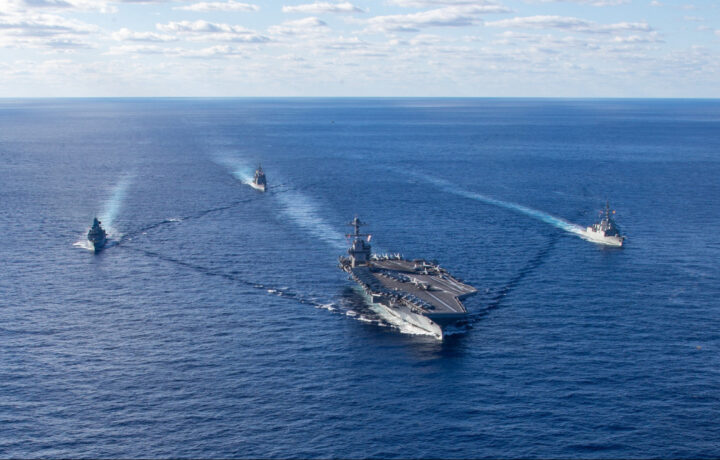It has been nearly a year since Hamas launched its attack into southern Israel, igniting the ongoing conflict in Gaza. In response, the United States has maintained a near-constant presence in the region in hopes of deterring escalation, and to confront the region’s Iranian-backed groups if necessary. The U.S. Navy has seen a rotation of aircraft carriers, extending the deployments of the USS Gerald R. Ford (CVN-78), and the USS Dwight D. Eisenhower (CVN-69).
In early September, the USS Theodore Roosevelt (CVN-71) departed the region eight months into her deployment but only after U.S. Secretary of Defense Lloyd Austin ordered the USS Abraham Lincoln (CVN-72) to rush to the Middle East from the West Coast of the United States. The USS Harry S. Truman (CVN-75) is now on route to the region from the East Coast – and both CVN-72 and CVN-75 will remain as the likelihood of a wider conflict has increased as Israel could launch a ground invasion of southern Lebanon to confront the Tehran-back Hezbollah.
USS Harry S. Truman was ordered to the region to relieve USS Abraham Lincoln, but on Sunday, Austin ordered CVN-72 to remain in the U.S. Central Command area of responsibility to increase America’s presence. The carrier is now operating in the Arabian Sea.
Another Flattop is Also Ready to Respond
In addition to two Nimitz-class nuclear-powered supercarriers operating in the Middle East, the U.S. Navy had deployed the amphibious assault ship USS Wasp (LHD-1), along with the embarked 24th Marine Expeditionary Unit (MEU), to the Eastern Mediterranean earlier this past summer. LHD-10 is being supported by the San Antonio-class amphibious transport dock USS New York (LPD-21) and Harpers Ferry-class dock landing ship USS Oak Hill (LSD 51).
The Wasp Amphibious Ready Group is now in place to respond should the need arise for a non-combatant evacuation of Americans from Lebanon. USNI News reported that evacuating civilians from conflict zones is one of the “major missions” that MEUs are trained for.
Though not officially an “aircraft carrier,” LHD-1 is nearly as large as conventionally powered carriers operated by the navies of other nations. Its airwing includes Marine-flown F-35B multirole fighters – the short takeoff and vertical landing (STOVL) variant of the U.S. military’s Joint Strike Fighter. The ready group, which began its deployment in April, has been operating in the Mediterranean since June – replacing a similar group of amphibious warships led by the USS Bataan (LHD-5), another Wasp-class LHD.
Expanded U.S. Presence
In addition to the two carrier strike groups (CSGs), and the ARG, several U.S. Navy warships, including guide-missile destroyers and littoral combat ships (LCS) have been independently deployed to the Eastern Mediterranean and Red Sea to counter attacks from drones and missiles.
It was just last Friday that the Arleigh Burke-class guided-missile destroyers USS Spruance (DDG-111), USS Stockdale (DDG-106), and Littoral Combat Ship USS Indianapolis (LCS-17) came under attack from cruise missiles and one-way drones fired by the Houthi militant group operating in Yemen.
“We did see a complex attack launched from the Houthis that ranged from cruise missiles and [one-way attack drones],” Pentagon spokeswoman Sabrina Singh told reporters on Friday. “My understanding is that those were either engaged in, shot down or failed.”
In recent months, the Pentagon has increased the number of military aircraft in the region – including an undisclosed number of F-22 Raptors, F-15E Strike Eagles, F-16 Fighting Falcons, and A-10 Thunderbolt II aircraft. The Department of Defense (DoD) also announced it would increase the defensive air-support capabilities “in the coming days.”
Strong Presence in the Middle East Left Indo-Pacific Shorthanded
The increased presence and the rotation of carriers to the Middle East have highlighted the shortage of U.S. warships operating in the Indo-Pacific. Throughout much of August and September, the U.S. Navy maintained almost no carriers in the region as the USS Ronald Reagan (CVN-76) returned to San Diego after serving as the U.S. Navy’s only forward-deployed aircraft carrier operating from Japan. She recently concluded a “hull swap” with USS George Washington (CVN-73), which will take over as the Navy’s only forward-deployed carrier.
Given the shortage of carriers, the U.S. Navy will likely continue to have to rotate its flattops as much as possible to respond to the increasing number of global hotspots.




